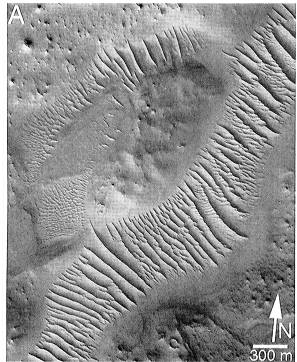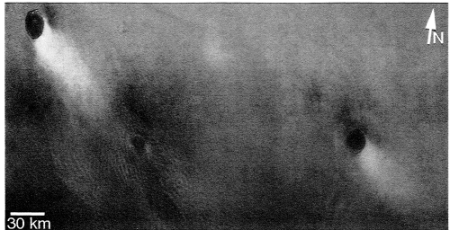The MOC “book”: Dunes, Ripples and Streaks
This is the fourth in a series of posts about the huge paper by Malin and Edgett summarizing the results from the Mars Orbital Camera’s (MOC’s) primary mission. If you’re just tuning in, get caught up by reading the first three posts, and if you want to read along, download a pdf of the paper here.
This week we’re looking at two sections: “Aeolian Processes and Landforms” and “Polar Processes and Landforms”. Also known as wind and ice features. These represent the most active features on the martian surface and they are also some of the weirdest looking! I’ll post about the aeolian features today and polar processes tomorrow since both have tons of images to go with them.
The authors make a distinction between dunes, which are always dark-toned and are likely made of sand-sized volcanic minerals, and ripples which are smaller, and are often light toned. This picture shows exactly what each term refers to:

Examples of dark-toned dunes overriding light-toned ripples. The arrows point to the most obvious places where the dunes are on top of the ripples.
The dark-toned dunes come in a variety of shapes, depending upon the amount of sand available and the wind direction. Figure 39 of the paper shows several of the types of dunes:

a) Thick sand sheet; b) These dunes are likely inactive - they have been eroded into more rounded shapes than you would expect to see on an active dune.; c) Barchan dunes near the north pole. d) Stubby barchan dunes. The wind is blowing from bottom to top in this figure ;e) Barchan dunes that extend far downwind (toward bottom right) become linear "seif" dunes ; f) Dunes near the north pole showing a "rectilinear" pattern.
By comparing MOC observations with older Viking images, Malin and Edgett tried to detect evidence for dune movement. But even over 10-14 martian years, no dunes were seen to move. Not all dunes on Mars are inactive though: MOC did see streaks appear on the downwind sides of some dunes indicating that sand was moving.

An example of dunes with avalance streaks on their slip faces.
As for ripples, they are almost everywhere on Mars. Interestingly, they are often much larger than ripples seen on earth, and they are always perpendicular to the wind direction. When they are in troughs, they are always perpendicular to the trough trend, and they even “refract” around obstacles, following the surface winds.
The ripples are very similar in size to some of the ridged units mentioned earlier in the paper, but whether they are actually related is not clear.

Giant granule ripples. Notice that the ripples are oriented perpendicular to the trough that they are in, indicating that the wind that formed the ripples was blowing along the trough.
Some of the most dramatic changes on the martian surface occur when dust is lifted or deposited, leaving either a dark or light wind streak. Wind streaks typically form behind some sort of topographic obstacle that disrupts the wind and causes turbulence which lifts dust, or alternately causes a space with less wind, causing dust to collect there.Some wind streaks are also composed of frost.

Large wind streaks composed of frost.

Hundreds of small wind streaks tracing the wind flow over topography. The surface is covered in frost and the narrow end of the streaks point downwind.
Dust devils are also very common on Mars, and they leave intricate patterns in their wakes as they vacuum dust from the martian surface. This figure shows a bunch of examples, including some dust devils caught in motion:

A collection of photos of dust devil streaks. c is a rare example of light-tones streaks, and h&i are examples of dust devils caught in action.
Of course, with the wind blowing sand and dust around on the surface, it makes sense that wind erosion is the most active erosional process on Mars today (unless you count the sublimation of the polar caps). Here is an example of terrain that has been eroded by the wind into a ridged and grooved pattern (also known as “yardangs”).

Most of the visible surface here is eroded by the wind into yardangs.
That concludes the aeolian section of the paper. Tomorrow I’ll be posting about polar processes, with lots more cool pictures!
![]() Michael C. Malin, Kenneth S. Edgett (2001). Mars Global Surveyor Mars Orbiter Camera: Interplanetary cruise through primary mission Journal of Geophysical Research, 106 (E10), 23429-23570 DOI: 10.1029/2000JE001455
Michael C. Malin, Kenneth S. Edgett (2001). Mars Global Surveyor Mars Orbiter Camera: Interplanetary cruise through primary mission Journal of Geophysical Research, 106 (E10), 23429-23570 DOI: 10.1029/2000JE001455